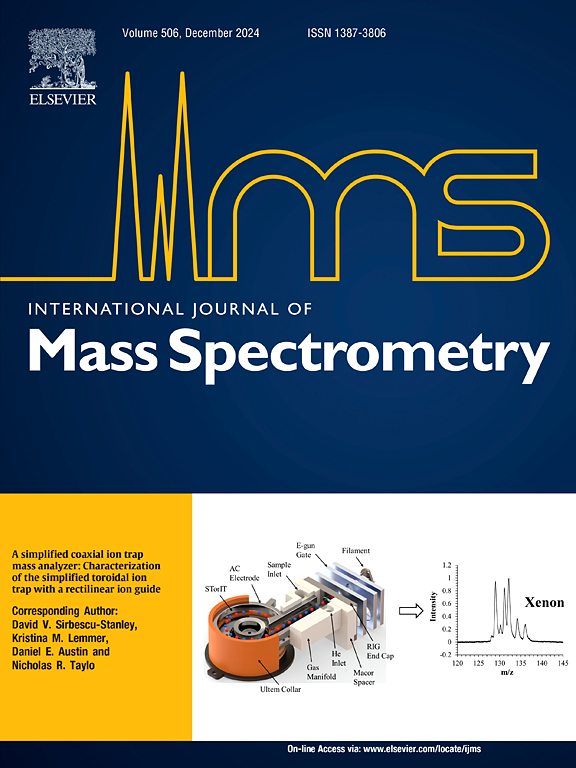高温和超高温反应动力学的单纳米粒子质谱分析
IF 1.7
3区 化学
Q3 PHYSICS, ATOMIC, MOLECULAR & CHEMICAL
引用次数: 0
摘要
提出了一种非破坏性的、光学检测的单纳米粒子(NP)质谱方法,目的是在高温下提取单纳米粒子的表面反应动力学。讨论了确定NP电荷、质量和温度作为时间函数的方法,并利用这些数据提取质量变化的绝对动力学,以及引起它们的表面过程的效率。讨论了导致绝对质量和相对质量测定以及由此产生的动力学参数不确定的因素。该方法允许直接测量NP到NP的初始反应性变化,以及在反应条件下发生的NP结构/组成变化引起的反应性的时间演变。本文讨论了单纳米粒子质谱作为一种高温表面动力学工具的优势和局限性,并在2400 K以上的温度范围内对单铪(Hf) NPs进行了升华和O2氧化动力学实验。将Hf氧化动力学与硅、石墨和炭黑NPs的类似氧化实验进行了比较。在所有四种情况下,氧化化学主要是导致净质量损失的过程,并讨论了不同的机制。所有四个NPs最终也都钝化了,即,相对于初始效率,氧化蚀刻的效率至少下降了两个数量级。讨论了与硅或铪相比,碳的钝化机理有很大不同。碳的NP钝化归因于结构异构化导致完全配位的类富勒烯NP表面,而对于硅和铪,钝化是由于NP亚表面区域中氧的积累导致氧化层的延迟形成。本文章由计算机程序翻译,如有差异,请以英文原文为准。

High and ultra-high temperature reaction kinetics by single nanoparticle mass spectrometry
Methodology is presented for non-destructive, optically-detected single nanoparticle (NP) mass spectrometry, with the goal of extracting surface reaction kinetics for single NPs at high temperatures. Methods for determining the NP charge, mass, and temperature as a function of time are discussed, and the data are used to extract both the absolute kinetics for mass change, as well as the efficiencies of the surface processes that cause them. Factors that contribute to the uncertainties in absolute and relative mass determination, and in the resulting kinetic parameters, are discussed. The method allows the NP-to-NP variations in initial reactivity to be measured directly, along with the time evolution of reactivity resulting from NP structural/compositional changes that occur under reaction conditions.
The strengths and limitations of single nanoparticle mass spectrometry as a high temperature surface kinetics tool are discussed in the context of sublimation and O2 oxidation kinetics experiments for single hafnium (Hf) NPs at temperatures ranging above 2400 K. The Hf oxidation kinetics are compared to analogous oxidation experiments for silicon, graphite, and carbon black NPs. In all four cases, the oxidation chemistry was dominated by processes that result in net mass loss, and the distinct mechanisms responsible are discussed. All four NPs also eventually passivated, i.e., the efficiencies for oxidative etching decreased by at least two orders of magnitude, relative to the initial efficiencies. The passivation mechanisms, which are quite different for carbon, compared to silicon or hafnium, are discussed. Carbon NP passivation is attributed to structural isomerization leading to fully coordinated, fullerene-like NP surfaces, while for silicon and hafnium, passivation results from delayed formation of an oxide layer, triggered by accumulation of oxygen in the NP sub-surface region.
求助全文
通过发布文献求助,成功后即可免费获取论文全文。
去求助
来源期刊
CiteScore
3.60
自引率
5.60%
发文量
145
审稿时长
71 days
期刊介绍:
The journal invites papers that advance the field of mass spectrometry by exploring fundamental aspects of ion processes using both the experimental and theoretical approaches, developing new instrumentation and experimental strategies for chemical analysis using mass spectrometry, developing new computational strategies for data interpretation and integration, reporting new applications of mass spectrometry and hyphenated techniques in biology, chemistry, geology, and physics.
Papers, in which standard mass spectrometry techniques are used for analysis will not be considered.
IJMS publishes full-length articles, short communications, reviews, and feature articles including young scientist features.

 求助内容:
求助内容: 应助结果提醒方式:
应助结果提醒方式:


